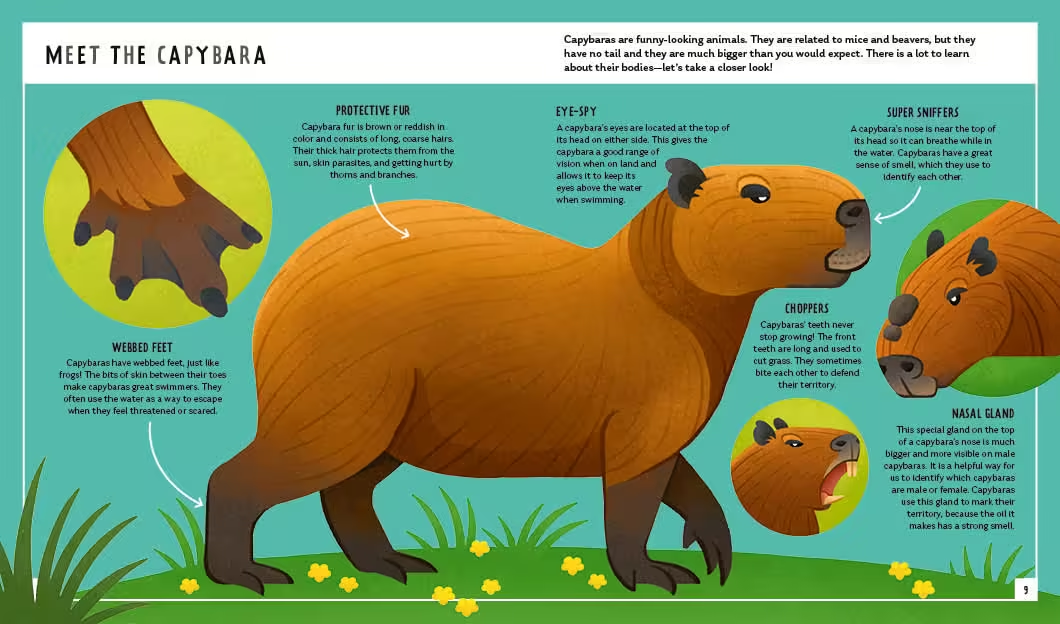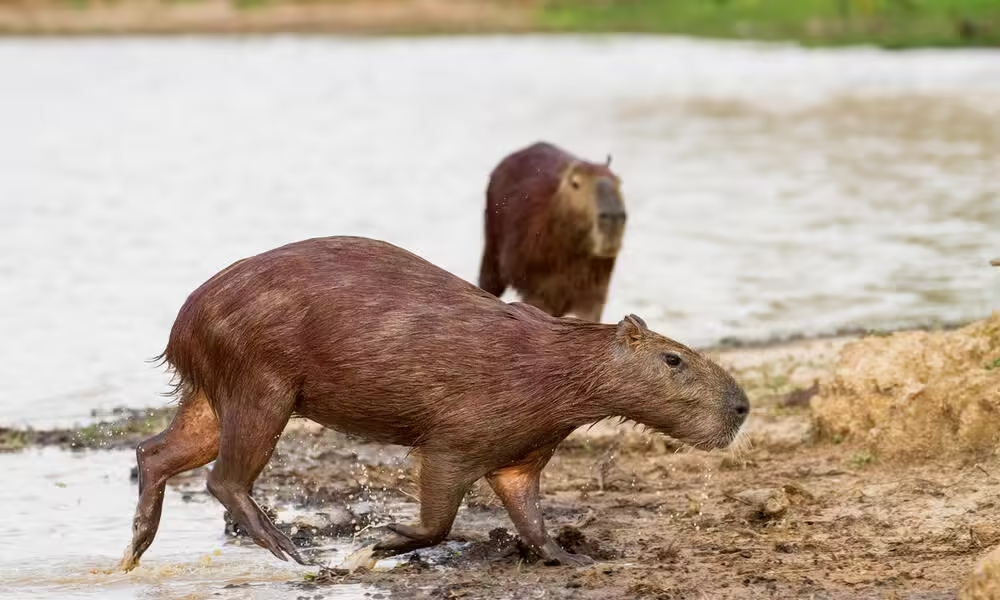Capybaras go through different life stages from birth to adulthood. Knowing about these stages helps us understand their biology, social life, and how they adapt to their homes.
Capybaras live in warm places, like estuaries, marshes, and rivers. They get about 2.3 meters of rain each year. This rain pattern affects their life cycle and how they interact with each other.
Capybaras love to be around others. They usually live in groups of about ten. But sometimes, they gather in groups of up to 100. The Hydrochoerus isthmius subspecies is different, preferring to be alone most of the year.
Key Takeaways
- Capybaras experience distinct life stages from birth to adulthood.
- They thrive in tropical and subtropical wetland environments, with a preference for estuaries, marshes, rivers, and streams.
- Capybaras are highly social animals, living in herds or groups, with group sizes typically averaging around ten individuals.
- The Hydrochoerus isthmus subspecies exhibits a more solitary lifestyle outside of the dry season.
- Understanding the capybara’s life cycle is crucial for their successful care and conservation in both wild and captive settings.
What Are the Different Life Stages of a Capybara?
Capybaras, the world’s largest rodents, go through many life stages. These stages are key to understanding their growth and development. It’s fascinating to see how they mature and evolve.
Infant Stage (Birth to 1 Year)
Capybara infants are born ready to move and follow their mothers. They nurse for about 16 weeks. During this time, they also get milk from other females in the group.
These young capybaras rely on their mothers and the group for safety and food. It’s a crucial period for their growth.
Juvenile Development
When capybaras reach the yearling stage, they start to leave their parents’ group. By 18 months, they weigh about 40 kg. They’re getting close to their adult size.
Adult Maturation
Capybaras mature at different times. Females are ready to breed between 7 to 12 months. Males take longer, reaching adulthood between 15 and 24 months.
Once they’re fully grown, capybaras can weigh between 35 to 66 kg. Females are often a bit bigger than males.
The life stages of the capybara show their amazing growth. From being vulnerable infants to becoming independent adults, each stage is important. It helps them survive and thrive in their social groups.
Birth and Early Development of Baby Capybaras
The birth of a capybara is a remarkable event. These gentle giants welcome their young after a 150-day gestation. Capybara litters usually have 4 to 5 pups, each weighing 2 to 3 pounds at birth.
Newborn Characteristics
Capybara pups are born with a surprising level of maturity. Their cheek teeth are already erupted and show wear, ready to graze on grass soon after birth. These precocial infants can follow their mother and explore their surroundings almost immediately.
First Weeks of Life
In the first few weeks, capybara pups stay close to their mother and the herd. They may even ride on the backs of adult females. This safe and comfortable mode of transportation helps them learn to navigate their new environment.
Nursing Period
Capybara pups nurse for about 16 weeks. During this time, they form small groups and move about the herd. They will nudge females until one stands to nurse. This communal nursing is key to their social structure and survival.
| Milestone | Age | Weight |
|---|---|---|
| Birth | 0 days | 2-3 pounds (1,500 grams) |
| Weaning Completion | 16 weeks | Up to 29-33 pounds |
| 1 Year | 12 months | Up to 88 pounds |
| Sexual Maturity | 18 months | 88-146 pounds |
The early development of capybara pups is remarkable. They grow fast, show precocial behavior, and form strong social bonds. As they navigate their first months, they show incredible adaptability and resilience. This has helped capybaras thrive in their natural habitats.
Social Structure and Group Dynamics
The capybara is a unique semi-aquatic rodent known for its complex social structure. These large, social mammals live in groups of 6 to 16 adults. Female capybaras often lead the group.
When water is scarce, capybara groups can grow to 100 members. But during the wet season, they split into smaller groups of about 40. This change shows how capybaras adapt to their environment.
| Metric | Value |
|---|---|
| Typical Group Size | 6 to 16 adults |
| Dry Season Group Size | Up to 100 individuals |
| Wet Season Group Size | Up to 40 individuals |
| Territorial Range | 2 to 200 hectares (4.9 to 494 acres) |
| Average Territory Size | 5 to 20 hectares (12.4 to 49.4 acres) |
Capybara herds have a clear social order. A dominant male leads, with several adult females and their young. Subordinate males stay on the outside, with little chance to breed. The group’s hierarchy rarely changes.
Capybaras fiercely defend their territory. They bark at strangers and use scent to mark their land. Their territory is densely populated, showing how productive their habitats are.
They engage in play, grooming, and communication. They use visual, vocal, and olfactory signals. These interactions help keep the group together and ensure everyone’s safety.
Growth Milestones and Physical Development
Capybaras, the largest rodents, grow and change a lot from birth to adulthood. Newborns weigh about 1,500 grams (3.3 lbs). By 18 months, they can weigh up to 40 kg (88 lb).
Their physical changes are amazing. At birth, they have full cheek teeth, showing wear. This lets them eat grass soon after being born. As they grow, they get bigger and heavier, with adults reaching 65 kg.
Dental Development
The capybara’s teeth grow in fully at birth. This is rare among mammals. It lets them eat grass and other plants right away. This is key for their survival in the wild.
Weight Progress
- Newborn capybaras weigh about 1,500 grams (3.3 lbs).
- By 18 months, capybara subadults can weigh up to 40 kg (88 lb).
- Adult capybaras can weigh up to 65 kg, showing their impressive growth.
Physical Changes
As capybaras grow, they change a lot. They get much bigger, with adults reaching 65 kg. This fast growth shows how well they adapt to their environment.
“Capybaras are known as the largest rodent in the world, and their physical development is truly awe-inspiring.”
Reproductive Maturity and Breeding
Capybaras, the world’s largest rodents, have interesting ways of growing up and breeding. Capybara reproduction and capybara breeding are closely tied to their capybara sexual maturity. This varies by gender and age.
Females become ready to breed between 7 to 12 months old. Males take longer, reaching maturity between 15 and 24 months. Capybaras can mate all year, but most do so at the start of the wet season. Females are ready to mate every 7.5 days for just 8 hours.
Capybaras live in groups where one male mates with many females. The pregnancy lasts 150 days. Females usually have one litter a year, but can have two if conditions are right.
- Females reach sexual maturity between 7 to 12 months
- Males reach sexual maturity between 15 and 24 months
- Mating season peaks at the start of the wet season
- Females have estrus cycles every 7.5 days, with a receptive period of 8 hours
- Capybaras have a harem-based polygynous breeding system
- Gestation period is 150 days, with females typically having one litter per year
Knowing how capybaras reproduce and breed is key for their conservation. Their capybara sexual maturity and breeding habits are crucial for their survival and population growth.
Parental Care and Young Rearing
Capybara parental care is complex and fascinating. Female capybaras show deep care for their young. This highlights the strong family bonds in these social rodents.
Maternal Behavior
Capybara mothers are very dedicated to their babies. They spend a lot of time with them, teaching them survival skills. This care is key in the first weeks of life, as the young are helpless and need their mothers.
Group Care System
The group care system is also crucial. Capybara groups usually have six members. Everyone helps care for the young. This teamwork ensures the young get the care and learning they need to grow strong.
Survival Skills
- Young capybaras start learning survival skills early, like following their mother and eating grass.
- They learn to stay away from dangerous water, where predators like caiman and anaconda hide. This is a vital lesson for their safety.
- The group structure helps protect them and teaches them social and survival skills. This prepares the next generation to face their environment.
The capybara’s care for their young shows their social and cooperative nature. By combining maternal love with group support, they ensure their young thrive. This secures the future of their species.
Adult Life and Social Behavior
Adult capybaras live in complex groups. A group usually has a dominant male, several adult females, and their young. Subordinate males often stay on the outside of the group. They mark their territory by scent on trees and rocks.
When it’s mating time, the dominant male watches over the females. The females show they’re ready by whistling. Mating happens in water, with the female going underwater for a brief moment. This shows how complex their social lives are.
| Capybara Group Dynamics | Typical Group Size | Home Range |
|---|---|---|
| Capybara groups can vary in size from around 10 members up to 100 during different seasons, all led by a dominant male. | 10-100 individuals | 5-494 acres (2-200 hectares) |
Capybaras are very social, living in close-knit communities. They rely on teamwork and a clear hierarchy. Knowing about adult capybara behavior, capybara social structure, and capybara group dynamics helps us understand their lives better.
“The capybara is the largest rodent in the world, and its social behavior is a fascinating example of how these animals have adapted to their environment.”
Natural Lifespan and Aging Process
Capybaras, the world’s largest rodents, have a unique lifespan. In the wild, they live between 7 to 10 years. But, due to dangers like predators, their average life is about 4 years.
In safe environments, like zoos, capybaras live longer. Males live up to 7.1 years, and females up to 8.6 years. This is because they don’t face predators and get the right food and care.
Wild Population Longevity
In the wild, capybaras face many dangers. Jaguars, anacondas, caimans, and humans hunt them. These threats shorten their average life to 4 years. Yet, some wild capybaras can live up to 10 years, depending on their luck and environment.
Captivity Lifespan Differences
In safe places like zoos, capybaras live longer. Without predators and with good food and care, they can live up to 7.1 years for males and 8.6 years for females. This shows how important a safe environment is for their aging process.
| Population | Average Lifespan | Maximum Lifespan |
|---|---|---|
| Wild Capybaras | 4 years | 10 years |
| Captive Capybaras | 7.1 years (males), 8.6 years (females) | 12 years |
Conclusion
The capybara, the world’s largest rodent, goes through many life stages. Each stage is filled with important growth and social behaviors. From birth to adulthood, they show amazing adaptability and resilience.
These creatures have a complex social life. Their social structure is key to their survival and reproduction. Knowing about their capybara life stages summary helps in conservation and care in captivity.
Exploring the capybara lifecycle recap reveals their amazing adaptations and behaviors. Their journey from birth to adulthood shows their resilience and adaptability. This knowledge is valuable for researchers and caretakers.


